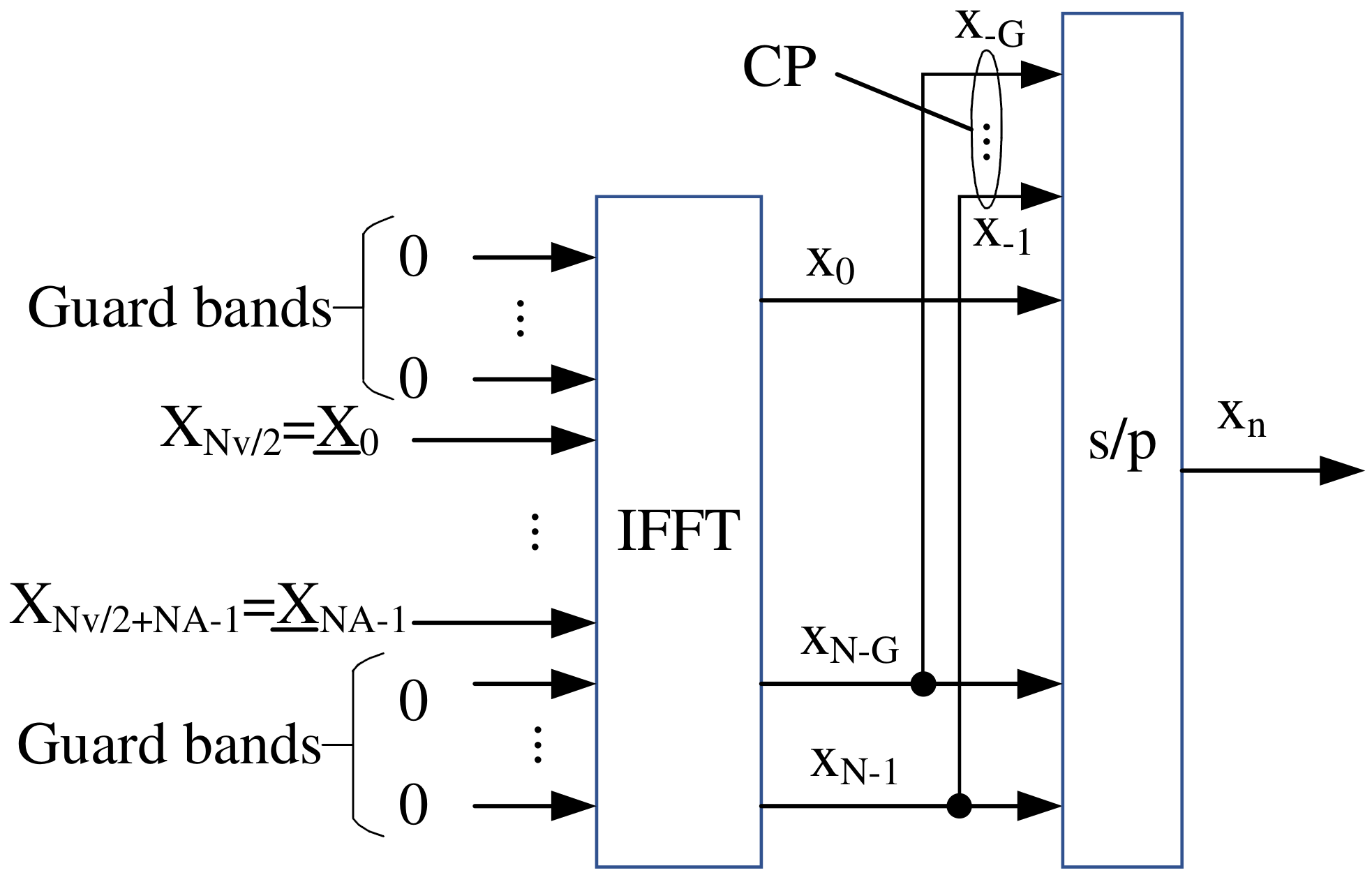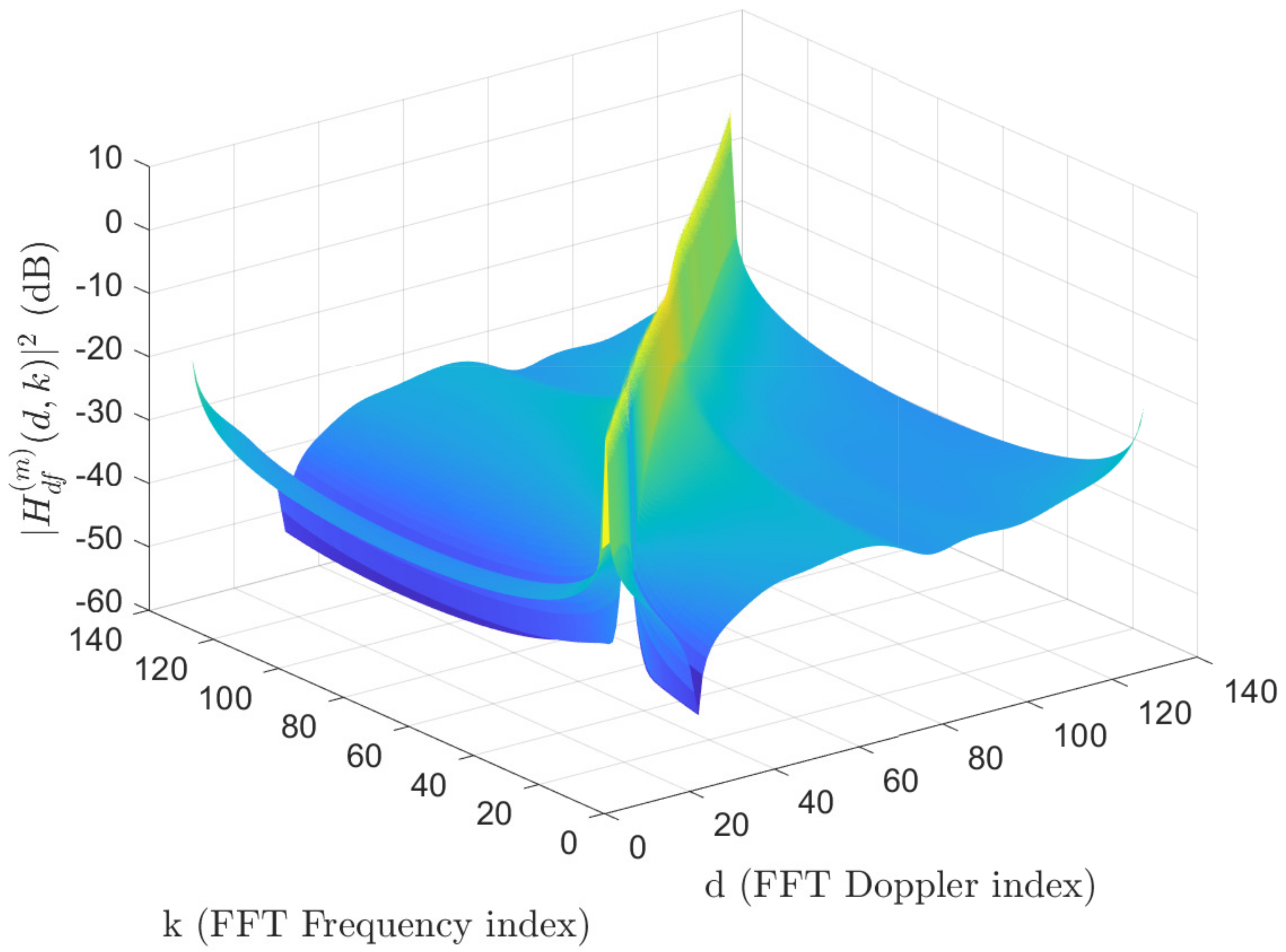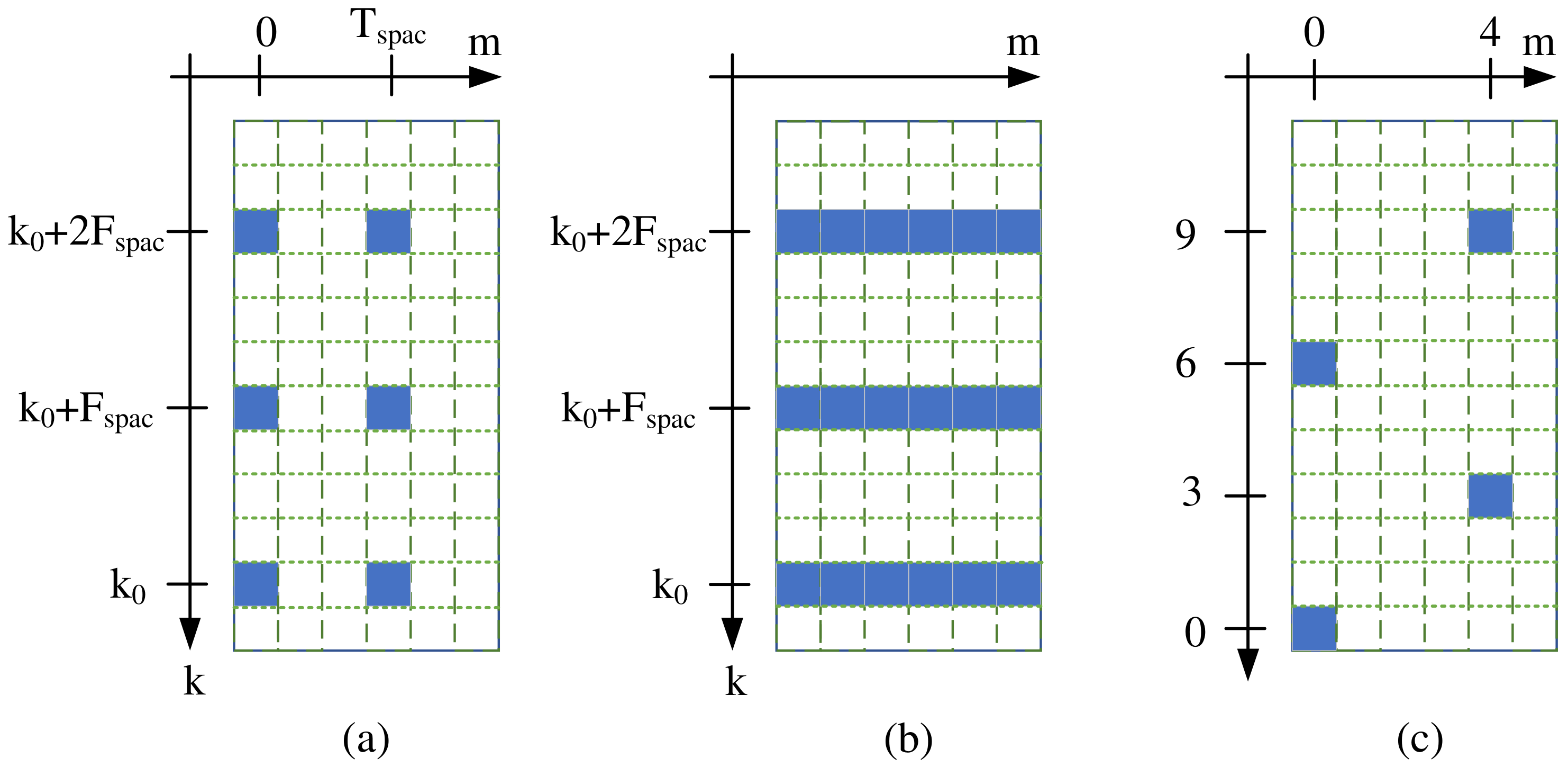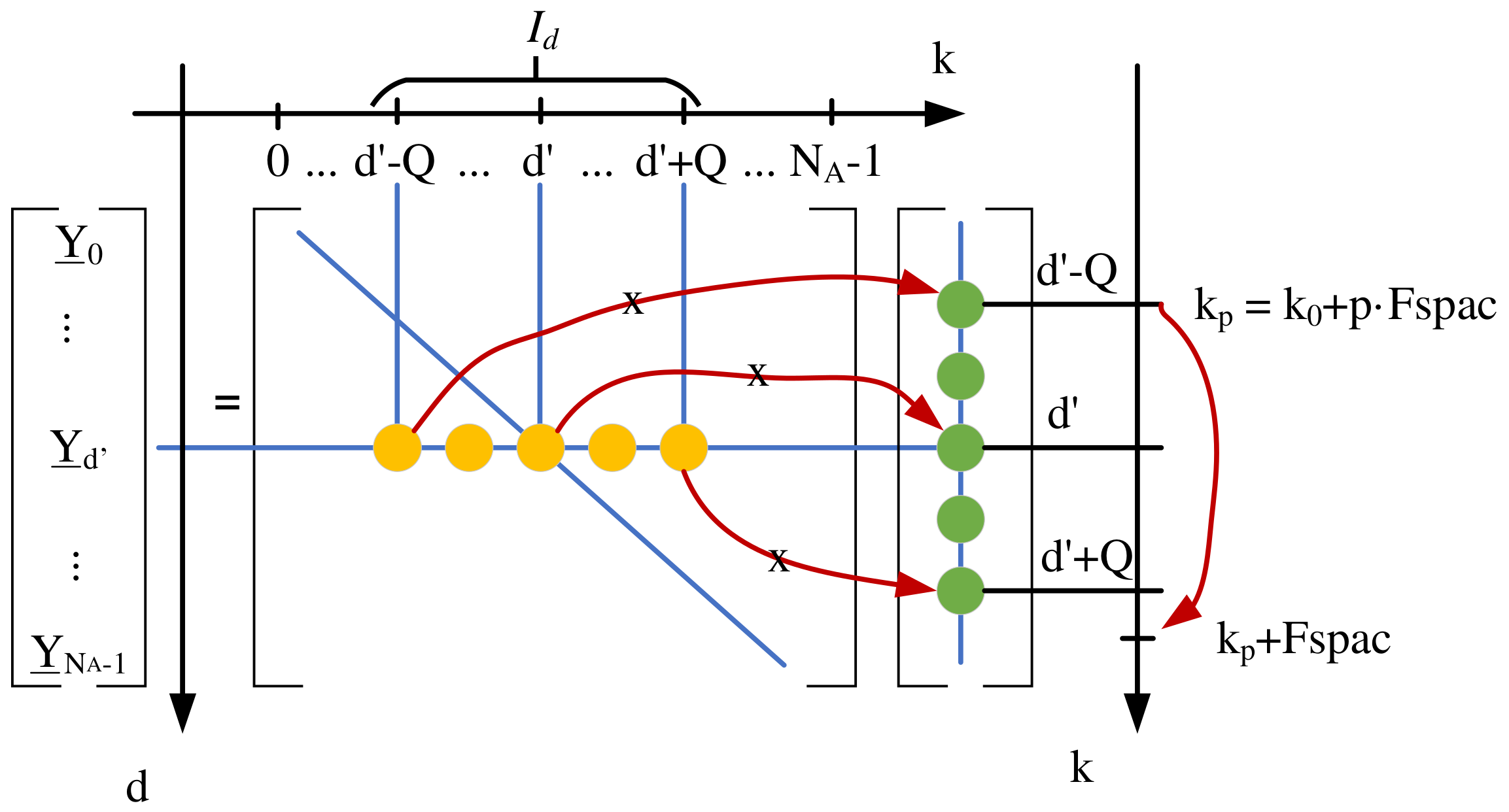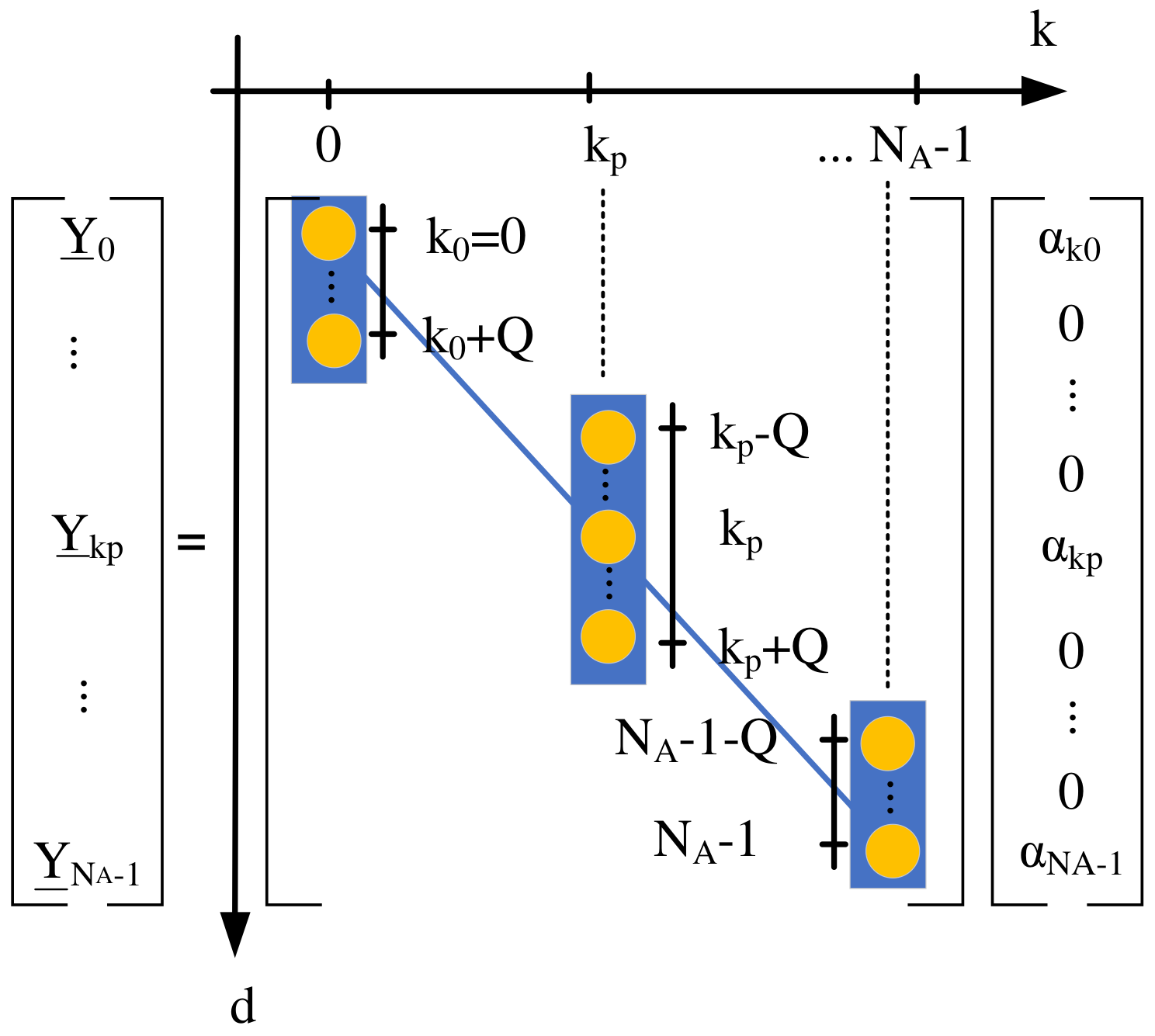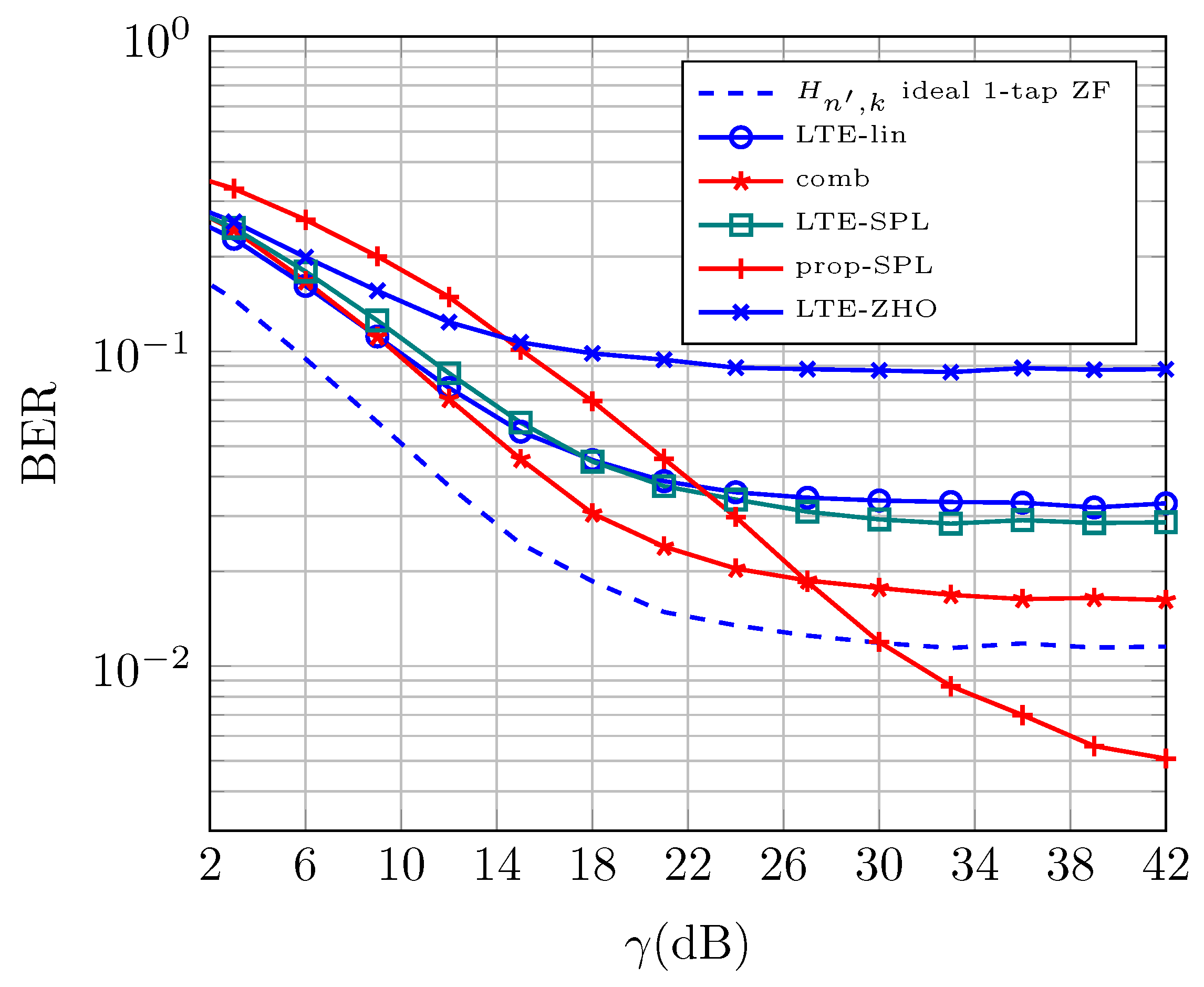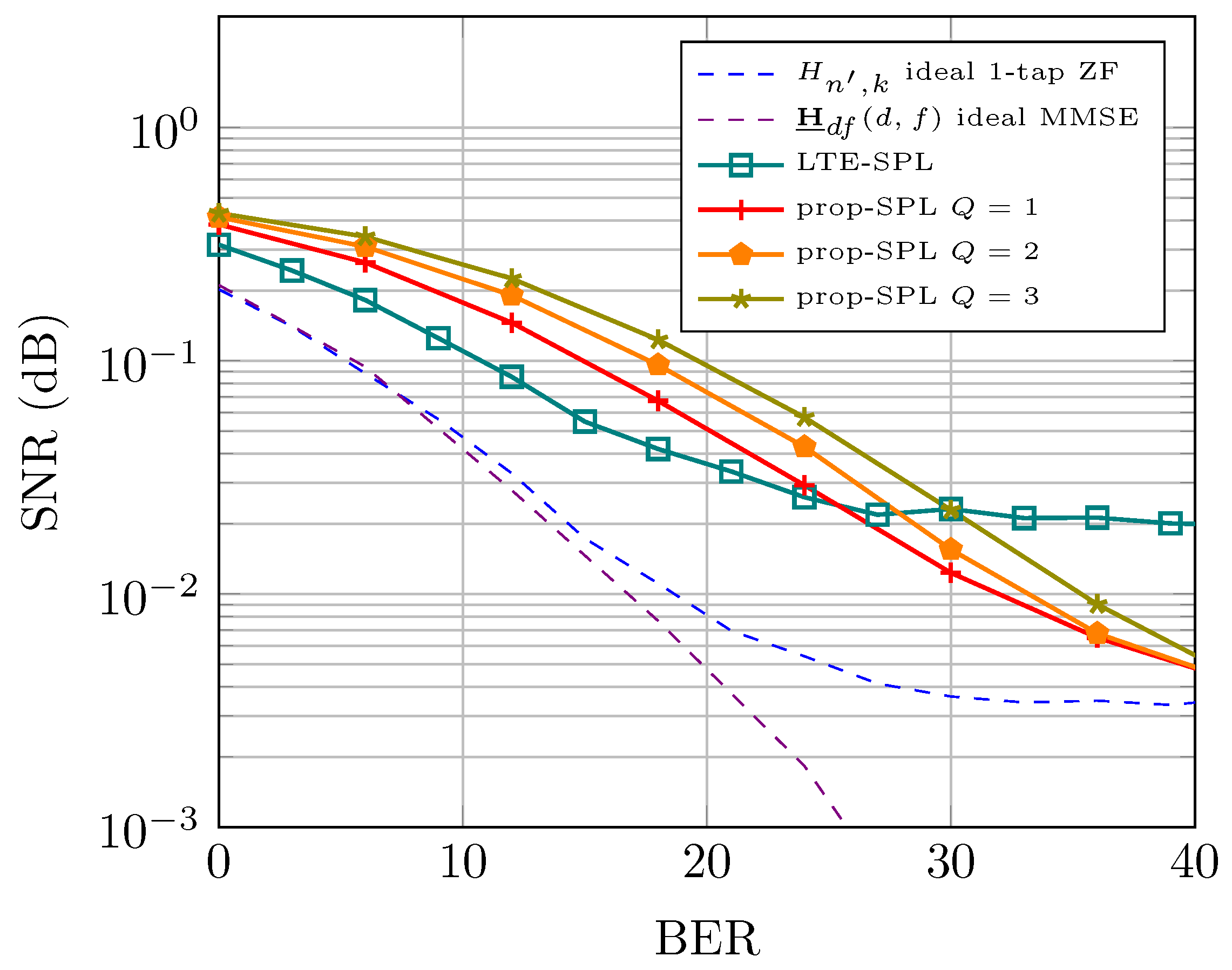1. Introduction
Orthogonal frequency division multiplexing (OFDM) has been widely applied to different areas such as digital video broadcasting, power-line communications, underwater communications, wireless local area networks and cellular communications, among others. This success is motivated by the fact that, with OFDM, the entire channel is divided into narrowband flat sub-channels, which are transmitted in parallel to maintain a high date rate. The use of OFDM provides the following two advantages: (1) OFDM is robust against frequency selective fading, allowing to perform a simple one-tap equalization; (2) OFDM provides further flexibility to use advanced techniques (on a sub-carrier basis) such as adaptive loading or transmit diversity, which improves the transmission efficiency [
1]. Nevertheless, in high mobility environments, such as the vehicular [
2,
3] and railway [
4] scenarios considered in 4G and 5G cellular networks, the coherence time of the channel can be smaller than the symbol duration. When this occurs, the orthogonality among sub-carriers is lost, leading to inter-carrier interference (ICI), which severely degrades the performance of OFDM. This issue has motivated an extensive area of research that has proposed different approaches to combat the ICI caused by the time-varying channel. These approaches can be categorized as: linear equalization, that involves estimating and inverting the channel matrix to cancel out the ICI; iterative interference cancellation, where estimated symbols from one iteration are used to mitigate the interference term and improve the symbol detection in the next iteration; and ICI self-mitigation, which requires a pre-processing of the OFDM symbols to reduce the ICI power or squeeze it among a reduced number of sub-carriers.
Linear equalization for ICI mitigation has received a lot of attention in early works, since it is the natural extension of the classical equalization used in the absence of ICI. In [
5], it is shown that under the assumption that the channel impulse response (CIR) varies in a linear fashion during a symbol period, the output/input relationship between transmitted and received OFDM symbols can be expressed as a diagonal-dominant sparse matrix (i.e., banded matrix). This matrix is known in the literature as subcarrier coupling matrixand it has dimensions
, being
N the fast Fourier transform (FFT) size. This band structure of the coupling matrix is used to reduce the complexity of the matrix inversion required to perform equalization, since the inversion of a
matrix is reduced to
inversions of
matrices, being
Q the number of non-zero diagonals. This complexity reduction is further improved on [
6], using Jacobi stationary iterative algorithm, and [
7], which uses low complexity
factorization for minimum mean square error (MMSE) equalization.
The linear model for the time variation of the CIR is also exploited in [
8]. In this work, the channel matrix is split into two components: mid-point and slope of the CIR that are estimated separately. Then, two methods are proposed to estimate the slope, which are based on the redundancy of the cyclic prefix (CP) and on the information of two OFDM symbols, respectively. However, the proposed method is still complex since it requires to perform several matrix inversions, FFT operations and channel interpolations to estimate the transmitted sequence.
A novel pilot pattern and channel estimation method for ICI mitigation is proposed in [
9]. The proposed pilot pattern is a combination of comb-type and grouped patterns that allows ICI mitigation with a small pilot density. Nevertheless, that scheme is numerically complex since it requires to obtain the most significant paths of the CIR, FFT operations and an iterative process to obtain the data.
Iterative interference cancellation [
10,
11,
12,
13,
14,
15] has been also widely investigated, since it has the potential to exploit the temporal diversity of the time varying channel to improve the performance. Nevertheless, the cost to pay is a higher computational complexity than linear equalizers like least squares (LS) and MMSE.
Finally, ICI self-mitigation is a promising approach that has attracted research interest in the last years. In [
16,
17,
18], a time domain window is applied on the received OFDM symbols to concentrate the ICI power on the main diagonal of the coupling matrix. Recently, in [
19] an adaptive windowing technique is proposed. This scheme is able to track directly an optimal receiver window in terms of average signal-to-interference and noise (SINR) ratio, requiring only linear complexity.
Other schemes reduce the ICI power instead of concentrating it. A correlative precoding scheme is proposed on [
20] to offer a balance between ICI self-mitigation, spectral confinement and peak-to-average power ratio (PAPR) reduction. In [
21] a mapping of each data symbol onto several sub-carriers with proper weighting coefficients is proposed to reduce the ICI power although the spectral efficiency is also reduced. In [
22,
23], an appealing scheme involving a linear combination of the ISI-free part of the OFDM symbols is proposed to suppress the ICI power. This scheme, which was treated heuristically in above works, is analyzed mathematically on [
24], to derive the optimum weights for the combination of the ISI-free part. Although the complexity of this scheme is reduced compared to other approaches, its performance is severely degraded if the delay spread is close to the CP length, since the ISI-free part is reduced. Although the ISI-free part might be increased by extending the CP length, it should be noted that this method leads to an undesired reduction in the spectral efficiency.
As can be noticed from the literature review, ICI mitigation is a challenging task, where finding an appropriate balance between receiver complexity, spectral efficiency, and bit error rate (BER) is complicated. On the one hand, iterative interference cancellation approaches offer a high performance in terms of BER at the expense of a prohibitively receiver complexity for many applications. ICI self-mitigation schemes greatly reduce the receiver complexity. However, they either require a pre-processing that is incompatible with existing communication standards, such as 4G Long Term Evolution Advance (LTE-A) or 5G New Radio (NR) [
20,
21], or they reduce the spectral efficiency [
22,
23,
24]. On the other hand, linear equalization has been proven to achieve a good performance with low complexity MMSE equalization [
7], and it can be implemented with existing communication standards. However, channel estimation is in this case challenging since ICI and channel variations between pilot symbols in the time domain may lead to outdated and noisy estimated channel samples [
25]. In addition, sophisticated channel estimation schemes can increase the receiver complexity, and the pilot pattern must be carefully devised to avoid reducing the spectral efficiency.
All these issues motivated us to investigate channel estimation and linear equalization for ICI mitigation with reduced complexity. In this paper we propose a low-complexity pilot pattern and a novel frequency domain coupling matrix estimation for ICI mitigation in OFDM systems. The proposed method uses a pilot pattern with some reserved sub-carriers to avoid ICI in the estimation of the channel matrix. Then, a low complexity factorization is used to mitigate the ICI through MMSE equalization. It is shown that the proposed method achieves a great improvement in terms of Bit Error Rate (BER) in the high Signal-to-Noise Ratio (SNR) regime, compared to existing approaches of similar complexity, which are based on classical 1-tap zero forcing.
The rest of the paper is structured as follows. The system model that considers the definition of sub-carrier coupling matrix, the OFDM modulation and classical channel estimation, interpolation and equalization, is presented in
Section 2. The proposed pilot pattern and low complexity channel estimation is described in
Section 3. Next, the low complexity channel equalization that relies on the band structure of the channel coupling matrix is presented in
Section 4. Finally, numerical results showing the benefits of the proposal and the conclusions drawn from this work are detailed in
Section 5 and
Section 6, respectively.
Notation: Matrices and vectors are represented in bold. The -th element (i.e., i-th row and j-th column) of a given matrix, , is represented as . The same holds for vectors, e.g, and . Transpose and conjugate transpose operations are represented as and respectively. Being a set, represents its number of elements. stands for the integer numbers, whereas stands for the natural numbers including , i.e., . represents the interval of integer numbers ranging from a to b with an unitary step, which is also expressed as . stands for the modulo operation between a and b, which is the remainder of the Euclidean division of a by b; and stands for the floor function. is the intersection of sets and . is the identity matrix of dimension N, and is the zero vector whose length is N. Finally, if H represents a given random variable (RV), represents an estimation of it.
3. Proposed Pilot Pattern and Frequency-Domain Coupling Matrix Estimation
In this section, the proposed pilot pattern is presented, which relies on the band structure of the coupling matrix to obtain interference free samples of it. To this end, our proposed pattern uses OFDM pilot symbols without data, thus allowing to perform a simple LS estimation, although at the expense of reducing the spectral efficiency.
We assume that
sub-carriers are active, and thus,
sub-carriers are used as guard band. Hence, we can write
, being
the transmitted vector in active sub-carriers. As can be observed, the sub-carrier indexes are shifted between the elements of these vectors, and hence, the
k-th element of
is expressed as
. From now on, the OFDM symbol index (
m) is neglected for notation simplicity. Equivalently, the received vector in active sub-carriers can be written as
, where
is the
matrix obtained by selecting the central block of
, i.e.,
.
and
are the central blocks of vectors
and
, respectively. It has been shown in [
16] and [
5] that the sub-carrier coupling matrix of the channel has a band structure, and the interference that undergoes the
k-th sub-carrier mainly comes from the
neighboring sub-carriers. This means that most of the energy of the coupling matrix relies in the
central diagonals; hence, it can be accurately approximated by a band matrix.
As proven in [
5], this banded structure is the result of the assumption that the CIR varies in a linear fashion within an OFDM symbol. It is shown in [
5] that this linear approximation is valid for normalized Doppler frequencies,
up to
, being
v the relative velocity in m/s,
c the light speed,
the carrier frequency in Hz, and
the OFDM sub-carrier spacing in Hz. In order to illustrate the banded structure of
,
Figure 3 shows the coupling matrix assuming a receiver speed of 500 km/h at a carrier frequency of 2 GHz. It can be shown that most of the energy is concentrated in a few bands close to the main diagonal.
Hence, the coupling matrix can be well approximated as its banded version, either if we include or exclude the guard bands, i.e.,
and
, where
If the coupling matrix follows the band structure of (
11), then, the received symbol in the frequency domain can be expressed as
The set can be obtained as the intersection of the set of sub-carrier locations with non-zero elements in the banded matrix, , and the range of active sub-carriers, .
Our proposed pilot pattern considers that OFDM symbols with pilots are spaced in
symbols, i.e., pilot symbols are transmitted periodically with period
. Since pilot symbols do not carry data, the efficiency of this scheme,
, computed as the ratio between sub-carriers used for data and useful carriers within a period, is given by:
For those OFDM symbols with pilots, the spacing between consecutive pilots is
sub-carriers in the frequency domain and the rest of sub-carriers in such symbols are reserved. Hence, being
an OFDM symbol with pilots,
if
and
if
, where
is the pilot value and
represents the set of pilot locations, which can be written as
The symbol
represents the smaller sub-carrier index with a pilot in the frequency domain, i.e., the first sub-carrier with pilots, whereas
p stands for the pilot tone index, ranging from 0 up to
, since the sub-carrier must fall within the interval
. It should be noticed that the set of sub-carriers with pilots can be also expressed in the equivalent form:
, where
stands for the modulo operation. The number of pilots per OFDM symbol is
. The proposed pilot arrangement, and the other two considered pilot patterns (comb-type and LTE CRS) are illustrated in
Figure 4.
Remark 1. The condition to obtain ICI-free samples of the channel coupling matrix according to (11) is , and hence, the minimum pilot spacing is . Proof. Figure 5 illustrates an sketch to prove the above remark. It can be observed that, due to the banded structure of the coupling matrix, the received symbol,
, depends on the weighted sum of transmitted complex symbols located at sub-carriers,
, which is represented as the multiplication and sum of yellow and green dots. If a given pilot location,
, falls within the interval
, then to avoid ICI, the next pilot tone at
must be located outside
. The case that require the greater
is the one where a pilot tone is placed at
, which is the case shown in the figure. In this case to avoid ICI, the following inequality must be fulfilled:
, which imposes that the next pilot tone is located outside
. Solving the above inequality leads to the ICI free condition,
. It should be noted that the value of
leads to the highest number of interference-free samples of the coupling matrix. □
If the above ICI-free condition is fulfilled, then, the received complex symbol at a given sub-carrier can be expressed as follows
In view of (
15) it can be noticed that there can be sub-carrier locations,
d, where not pilot tone is received, only noise, when the intersection of the pilot sub-carrier locations,
, and
is the empty set. In addition, it can be observed that if
, then there is a single sub-carrier location,
, that contributes to the received signal. Therefore, it is possible to obtain interference-free samples of the coupling matrix with a LS criterion as:
Remark 2. Let us consider that pilot locations are defined according to and ICI-free conditions as per Remark 1 are fulfilled, i.e., ; then, from (16), columns of are sampled, whose locations are also defined according to . The overall number of samples of the coupling matrix, , can be expressed aswhere . Proof. If ICI-free conditions are fulfilled, then, a received complex symbol on sub-carrier,
d, satisfying
, represents a weighted noised sample of a single element of the coupling matrix,
, as per Remark 1 and (10). On the other hand, the received OFDM symbol in the frequency domain can be written as follows
where
represents the k-th column of the coupling matrix
. Since the OFDM symbol in the frequency domain,
, is a pilot symbol, then
, and thus
where
. As can be observed from (14),
columns of
are sampled. The number of samples per column is determined by the sub-carrier locations of pilot tones,
, which falls within the inteval
and by the band structure of the coupling matrix as per (7), which involves that non zero elements fulfill
. Hence, the set of natural numbers that represent the sampled rows, d, of the
-th column of
can be expressed as follows
where (b) comes from combining the two inequalities from (a). Finally, computing the number of elements of
and summing for all the sampled columns completes the proof. □
Figure 6 illustrates an sketch of the number of elements sampled per column as determined with Remark 2. Three pilot tones are shown: one located at
in the frequency domain; a second one located at
; and a third one located in the last sub-carrier,
. It is observed that the limits on the sub-carrier indexes affect the first and last pilot tone, reducing the number of sampled elements in the first and last sampled columns of the coupling matrix. Hence, the sampled rows of the first column range from 0 up to
Q, whereas the last column has sampled rows ranging from
down to
. The second sampled column is different in the example of the figure. In this case, the sampled column is far from the sub-carrier edges, and the sampled rows range from
up to
.
Example: To illustrate the coupling matrix estimation, let us consider the case
,
and
. Hence, the locations of the pilots in the frequency domain are expressed as
and the received vector of useful sub-carriers related to an OFDM symbol with pilots can be expressed as
According to Remark 2, we obtain samples of the coupling matrix for the 0-th, 3-th and 6-th columns of : , , , , , , . Where the -th element of is represented as . It should be noticed that it is straightforward to obtain more samples of the coupling matrix if the received symbol power of guard band sub-carriers in the neighborhood of the 0-th and -th sub-carriers are estimated. However, the performance improvement is negligible when is high.
Channel interpolation: once samples of the coupling matrix are estimated, an interpolation of the samples is performed to estimate the coupling matrix. However, since the energy of each diagonal may be very different, instead of applying a two-dimensional (2D) interpolation method, we propose performing a 1D spline interpolation, i.e., a 1D interpolation for each of the main diagonals. With the proposed method and pilot pattern, we estimate the channel coupling matrix for every OFDM symbol with pilots. However, between OFDM pilot symbols, there are data symbols. In addition, a spline interpolation in the time domain is also proposed to track the time variations of the coupling matrix.
5. Numerical Results
The performance of the proposed method is assessed in terms of BER for Quadrature Phase Shift Keying (QPSK) modulation, using the ITU-Vehicular A channel [
32]. The carrier frequency is 2 GHz and the mobile speed is 540 km/h. We is consider an OFDM system with sub-carrier spacing of 15 kHz and a sampling rate of
MHz. Unit transmit power is considered for all the sub-carriers, i.e.,
,
. The rest of parameters are given in
Table 1. The CP length at a sampling rate of
MHz yields
μs of guard time, which is longer than the maximum delay spread of the channel, and thus, there is no ISI.
With these parameters, the efficiency of the proposed pilot pattern as given from (9) is
. It can be shown that the efficiency of comb-type pattern is,
, and thus, this pattern has also an efficiency of
with the above simulation parameters. Finally, the LTE CRS pattern has a high efficiency, since only four sub-carriers are reserved for pilot tones within a PRB and slot [
28], leading to
.
To assess the performance of the proposed pilot pattern and channel estimation for ICI mitigation, its performance is compared with other techniques of small complexity. Considered pilot patterns are: (1) comb-type [
33], with a frequency spacing between pilots of
; (2) the LTE pilot pattern [
32]; and (3) our proposed pilot pattern. With the comb and LTE patterns, it is only possible to estimate the main diagonal of the coupling matrix because of the ICI, and thus, a classical 1-tap ZF equalization is considered [
7]. Finally, we also analyze the case in which the main diagonal of the coupling matrix is estimated ideally (i.e., without ICI nor any other estimation error), but the transmitted data is obtained through 1-tap ZF equalization. This case is labeled as “
ideal 1-tap ZF” to clarify the equalization does not mitigate the ICI in this case, but the channel response is obtained without ICI. The frequency domain channel interpolation in all the cases is spline [
33]. However, for the time domain interpolation, the following methods are used: (1) zero-order hold (ZOH); (2) linear interpolation; and (3) spline interpolation. In case of comb-type pattern, since every OFDM symbols contain pilots, time interpolation is not performed.
Figure 7 illustrates the performance obtained with the methods mentioned above. The legend in the figure specifies the time-interpolation method and pilot-pattern, which is defined in
Table 2.
It can be observed that the proposed method with spline interpolation in the time domain achieves the best performance in the high SNR regime (prop-SPL). This is because our proposed pilot pattern and low complexity channel estimation allow obtaining the coupling matrix without ICI. In addition, the spline interpolation allows to obtain accurately the coupling matrix for the OFDM data symbols. The achieved BER in the high SNR regime is even smaller than with ideal channel estimation (ideal) of the main diagonal, since ICI mitigation is not performed in this case. The second best results (in terms of BER) are achieved by the comb type pattern (comb). This is because such a pattern offers pilots at every OFDM symbol, and hence, the channel information is not outdated for equalization purposes. However, the performance at the high SNR regime is limited by ICI in channel estimation and after equalization. The LTE pilot pattern provides a higher BER than previous pilot patters. On the other hand, ZOH interpolation provides the worst BER results whereas spline method achieves the lowest BER. This is because there is ICI in the channel estimation, the channel is outdated between OFDM symbols without pilots, and additionally, ICI is not mitigated with the equalization.
Lastly, results related to frequency-flat channel are illustrated on
Figure 8 to asses the performance of the proposed technique. To illustrate the bound on achievable performance, results of the perfect (ideal) estimation of the full coupling matrix (i.e., not banded assumption), with full MMSE matrix inversion is shown with a purple dash line. As can be observed in the noise limited region (i.e., in the low SNR regime), the ideal channel estimate with 1-tap (blue dashed line) and the ideal coupling matrix estimate with MMSE equalization achieves the same performance. Nevertheless, as the SNR increases the knowledge of the coupling matrix allows perfect ICI mitigation. Besides, in this figure it is shown the proposed technique for different values of
Q. It is shown that increasing
Q does not improve the performance. Nevertheless, with all these values of
Q BER is smaller that with the LTE pattern in the high SNR regime, which was also observed with
Figure 7.

